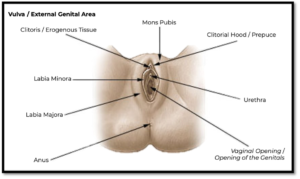By Brianna Green
I think anatomy is similar to fruit; it comes in different shapes, sizes, colors, tastes and smells. Someone can like a certain fruit or a variety of them. Furthermore, different places and people have different names for the same fruit. For example, in English we call a spherical, pale yellow shape with a reddish inside a “grapefruit,” but in Spanish it’s a “pomelo” and in Portuguese it’s called a “toranja.” Each place is correct in the way they refer to this fruit.
Whether you’re female, male, trans, intersex, or nonbinary, you might have the external anatomy that’s traditionally referred to as the “female” anatomy, but I’m going to refer to it as the external genital area. As anyone who has this area might know, it’s a little confusing. What are all the parts? What do they do? And what can they be called?
There is sometimes a misconception that the entire external area is referred to as the “vagina,” but this is incorrect. The vagina, also known as the internal genitals, does connect to the outside world, but it’s an internal structure. The external anatomy, according to MedicalNewsToday (MNT), is made up of the mons pubis and the vulva, which consists of the labia majora, labia minora, clitoral hood and clitoris, and the urethral and internal genital openings. You can also refer to this area as the external genital area. I’m going to use a diagram (below) to explore the external genital area and its’ different names and structures.
Starting with the mons pubis, is the fatty area above the external genital area that usually grows public hair. Next are the labias. The labia majora are the outer, fleshy lips on either side of the internal genital opening which usually grow hair (MNT). The labia minora, on the other hand, are the inner lips surrounding the openings; they do not grow hair and can vary in size and color. Their function is to protect the openings to the urethra and internal genitals.
Moving on to the clitoris, which can also be referred to as the erogenous tissue. This structure has a clitoral hood or prepuce. The hood is the fold of skin that surrounds the head of the erogenous tissue and protects it from friction (MNT). The erogenous tissue is pretty complex but, to keep it short, it sits at the top of the external genital area, is roughly the size of a pea, and tends to be sensitive (MNT). Below the erogenous tissue is the urethra, which is where urine comes out. Going south lies the vaginal opening or the opening of the genitals, which leads to the external structures that I’ll talk about another day. Finally, you have the perineum which is the skin between the external genital area and anus.
Although this was a general summary of the external genital area, not everyone’s anatomy is going to look exactly like this. For instance, intersex individuals may have ambiguous genitalia; and trans people who have not had (or don’t want) gender confirmation surgery may refer to their genitals differently. Here (https://massivesci.com/articles/sex-gender-intersex-transgender-identity-discrimination-title-ix/) is an article that explains sex but also what intersex is and how it is expressed. And here (https://youtu.be/Mb5umSACjcw) is a YouTube video, created by an OBGYN, for trans and nonbinary individuals who don’t want to use any of the terms I used for this type of genitalia. I hope this blog was educational and provided some clarity for everyone who has the external genital area!
Resources
http://www.phsa.ca/transcarebc/Documents/HealthProf/Gender_Inclusive_Language_Clinical.pdf
www.medicalnewstoday.com/articles/326898.
Diagram created by Brianna Green

